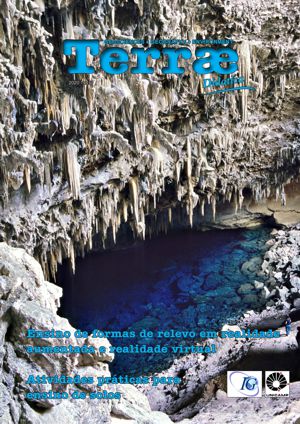Abstract
This paper shows the use of web resources for the creation of Virtual Reality (VR) and Augmented Reality (AR) environments to teaching of topographic surface concepts. Surface virtual mockups built with Sketchup software features include graphical representations of level contours, plan sections, and embankment slopes. The terrains textures used are satellite photos available by the Digital Globe platform and contribute to improve the visualization of studied concepts. Developed environments enable students to view AR surfaces through their webcam devices, such as smartphones, tablets, or notebooks, from a variety of points of view. Each topographic surface has a link to its respective representation in VR, which allows its manipulation and detailed study of each concept. The environments presented in this work can be used in disciplines of Topography, Geography and Descriptive Geometry.
References
Abdullah F., Kassim M.H.B., Sanusi N.Z. 2017. Go virtual: exploring augmented reality application in representation of steel architectural construction for the enhancement of architecture education. Advanced Science Letters, 23(2):804-808.
A-frame. 2019. A-frame documentation of Virtual Reality. URL: https://aframe.io/docs/0.8.0/introduction. Accesso 20.05.2019.
Akçayır M., Akçayır G. 2017. Advantages and challenges associ-ated with augmented reality for education: A systematic review of the literature. Educational Research Review, 20:1-11.
Andrade G., Oliveira A.C.C.A., Diniz M.C.A. 2018. Geografia e Sandbox: Contribuições da Realidade Aumentada para o Ensino das Formas de Relevo. In: III Congresso sobre tecnologias na Educação, Proc…, Fortaleza: Cultura Maker, p. 258-270.
Attardi S.M., Rogers K.A. 2015. Design and implementation of an online systemic human anatomy course with laboratory. Anatomical sciences education, 8(1):53-62.
Becker E.L.S., Nunes M.P. 2012. Relevo do Rio Grande do Sul, Brasil, e sua representação em maquete. Revista Percurso, 4(2):113-132.
Cantos L.C., Izquierdo J.L., Cantos E.C. 2016. Interactive multimedia application for teaching and learning in Analytical Geometry. IEEE Latin America Transactions, 14(7):3461-3466.
Carrera C.C., Asensio L.A.B. 2017. Landscape interpretation with augmented reality and maps to improve spatial orientation skill. Journal of Geography in Higher Education, 41(1):119-133.
Cerra P.P., Rodríguez J.G., Álvarez H.F., Parra B.B. 2018. Combining multimedia and self-assessment CAD tools in an interactive web environment to learn engineering drawing. Interactive Learning Environments, 27(2):1-14.
Digital Globe. 2019. Explore geospatial data in context. URL: https://www.digitalglobe.com. Accesso 20.05.2019.
Etienne J. 2017. Efficient Augmented Reality for the Web. URL: https://github.com/jeromeetienne/AR.js. Accesso 20.05.2019.
González N.A.A. 2017. Development of spatial skills with virtual reality and augmented reality. International Journal on Interactive Design and Manufacturing, 12(1):133-144.
Hinrichs T. 2019. An Orbit Controls Component for A-Frame VR. URL: https://github.com/tizzle/aframe-orbit-controls-component. Accesso 20.05.2019.
Huleihil M. 2017. 3D printing technology as innovative tool for math and geometry teaching applications. IOP Conference Series: Materials Science and Engineering, 164(1):1-7.
Irwansyah F.S., Yusuf Y.M., Farida I., Ramdhani M.A. 2018. Augmented Reality (AR) Technology on The Android Operating System in Chemistry Learning. IOP Conference Series: Materials Science and Engineering, 288(1):233-237.
Ishii H. 2010. Augmented Reality: Fundamentals and Nuclear Related Applications. International Journal of Nuclear Safety and simulation, 1(4):316-327.
Kirner C., Kirner T.G. 2011. Development of an interactive artifact for cognitive rehabilitation based on augmented reality. In: International Conference on Virtual Rehabilitation (ICVR’11), Proc…, Zurich: IEEE, p. 1-7.
McMenamin P.G., Quayle M.R., McHenry C.R., Adams J.W. 2014. The production of anatomical teaching resources using three-dimensional (3D) printing technology. Anatomical sciences education, 7(6):479-486.
Moro C., Stromberga Z., Raikos A., Stirling A. 2017. The effectiveness of virtual and augmented reality in health sciences and medical anatomy. Anatomical sciences education, 10(6):549-559.
Munoz-Cristóbal J.A., Gallego-Lema V., Arribas-Cubero H.F. et al. 2018. Game of Blazons: Helping Teachers Conduct Learning Situations That Integrate Web Tools and Multiple Types of Augmented Reality. IEEE Transactions on learning technologies, 11(4):506-519.
Murphy W. 2019. All-in-one natural hand controller, pointer, and gaze interaction library for A-Frame. URL: https://github.com/wmurphyrd/aframe-super-hands-component. Accesso 20.05.2019.
Oliveira J.R. 2018. Visualização de conteúdos multimédia num ambiente de realidade virtual. Porto: Universidade do Porto (Dissertação Mestrado). URL: https://repositorio-aberto.up.pt/bitstream/10216/111492/2/260772.pdf. Acesso 20.05.2019.
Santos E.T., Mafalda R., Kawano, A. et al. 2003. Da geometria cotada ao modelamento 3D: projeto didático. In: XVI Simpósio Nacional de Geometria Descritiva e Desenho Técnico e V International Conference on Graphics Engineering for Arts and Design, Proc…, Santa Cruz do Sul: ABEG, p. 1-7.
Santos R.S., Santos R.S., Alencar C.M.S., Macedo C.M.S. 2018. Realidade Aumentada no Processo de Ensino-Aprendizagem da Topografia em Projeto de Engenharia Civil. In: III Congresso sobre tecnologias na Educação, Proc…, Fortaleza: Cultura Maker, p. 582-589.
Serrano F. 2017. A-Frame teleport controls component. URL: https://git hub.com/fernandojsg/aframe-teleport-controls. Accesso 20.05.2019.
Sketchup. 2019. 3D Design Software. URL: https://www.sketchup.com. Accesso 20.05.2019.
Silva C.M., Ferreira G.C., Arribas-Cubero H.F. et al. 2008. Produção de material didático: jogo das curvas de nível. Boletim Goiano de Geografia, 28:157-170.
Sousa R.R. 2014. Oficina de maquete de relevo: um recurso didático. Terrae Didatica, 10(1):22-28.
Souza W.O., Espíndola, G.M., Pereira, A.R.A., Sá, L.A.C.M. 2016. A realidade aumentada na apresentação de produtos cartográficos. Boletim de Ciências Geodésicas, 22(4):790-806.

This work is licensed under a Creative Commons Attribution-NonCommercial 4.0 International License.
Copyright (c) 2020 Terrae Didatica


